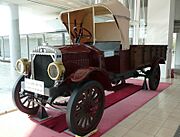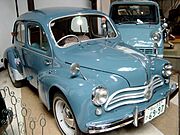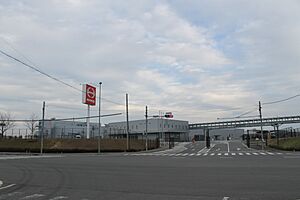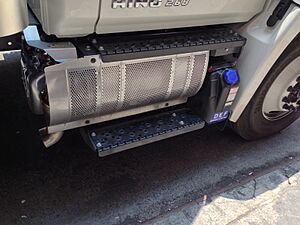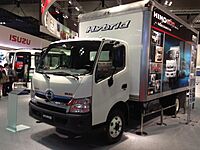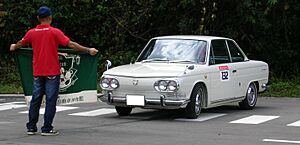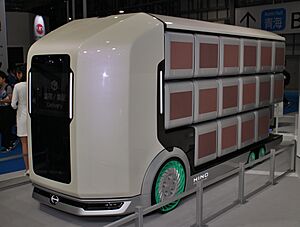Hino Motors facts for kids
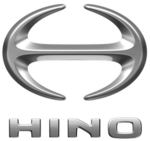 |
|

Hino Motors headquarters in Hino, Japan
|
|
|
Native name
|
日野自動車株式会社
|
|---|---|
|
Romanized name
|
Hino Jidōsha Kabushiki-gaisha |
|
Formerly
|
|
| Public (K.K) | |
| Traded as | TYO: 7205 |
| Industry | Automotive |
| Predecessor | Diesel Motor Industry Co., Ltd. |
| Founded | 1 May 1942 |
| Headquarters |
Hino, Tokyo
,
Japan
|
|
Area served
|
Worldwide |
|
Key people
|
|
| Products | Trucks and buses |
|
Production output
|
|
| Revenue | |
|
Operating income
|
|
| Total assets | |
| Total equity | |
|
Number of employees
|
34,231 (March 2023, consolidated) |
| Parent | Toyota |
Footnotes / references
|
|
Hino Motors, Ltd., often called Hino, is a Japanese company that makes commercial vehicles and diesel engines. These include engines for trucks, buses, and other vehicles. Hino's main office is in Hino, Tokyo, Japan. The company started in 1942, separating from older manufacturing businesses.
Hino Motors is a big part of the Nikkei 225 stock market index in Tokyo. It is also a part of the Toyota Group, which includes 16 major companies.
Contents
History of Hino Motors
Early Beginnings
Hino's story began with the Tokyo Gas Industry Company in 1910. This company made parts for gas companies. Later, it changed its name to Tokyo Gas and Electric Industry (TG&E). In 1917, TG&E built its first motor vehicle, a truck called the Model TGE "A-Type".
In 1937, TG&E's car-making part joined with other companies to form Tokyo Automobile Industry Co., Ltd. This company later became Diesel Motor Industry Co., Ltd., which is now known as Isuzu.
Hino's Start and Growth
In 1942, Hino Heavy Industry Co., Ltd. was created from Diesel Motor Industry Co., Ltd. After World War II, the company stopped making large marine diesel engines. It then focused on heavy-duty trucks, buses, and diesel engines. The company changed its name to Hino Industry Co., Ltd. It got its name from its headquarters in Hino, Tokyo.
In 1948, Hino split into two parts: Hino Diesel Industry Co., Ltd. and Hino Diesel Sales. In 1950, they launched the large TH10 truck with a new 7-liter diesel engine. In 1952, Hino introduced the B10/30 (Blue Ribbon) bus, which had a new design for Japanese vehicles. Hino also started making private cars in 1953 by building Renault cars under a special agreement. In 1961, Hino began making its own cars, like the Contessa sedan and the Hino Briska pickup truck.
In 1959, the company officially became Hino Motors, Ltd. The Hamura factory started making vehicles in 1963.
Joining Forces with Toyota
In the 1960s, Hino faced financial challenges. In 1966, Hino and Toyota formed a partnership. Hino became a part of the Toyota Group and focused on making trucks and buses. Hino also started assembling light vehicles for Toyota. For example, the Hino Briska pickup became the Toyota Briska. Hino stopped making its own passenger cars in 1969.
During the 1960s, Hino also launched new medium and heavy-duty trucks, like the Ranger. In the 1970s, Hino introduced "red" diesel engines that saved fuel. The company started exporting more vehicles, and by the end of the 1970s, Hino sold more vehicles overseas than in Japan.
Hino also made agreements with other car makers. In 1978, it worked with FAW in China to improve their trucks. In 1986, Hino licensed its engines to Ashok Leyland in India.
In the 1990s, Hino again faced financial difficulties. Toyota helped by giving Hino more assembly jobs. By 2001, Toyota owned more than half of Hino, making Hino a subsidiary of Toyota.
In 2002, Hino and Isuzu combined their bus production in Japan to create a company called J-Bus. Hino also partnered with Scania AB to sell Scania trucks in Japan. This partnership ended in 2011.
In 2012, Hino began moving its truck production in Japan to a new, larger plant in Koga, Ibaraki. This move was completed in 2017.
In 2018, Hino and Volkswagen Truck & Bus (now Traton) announced a partnership for things like buying parts and logistics. This partnership ended by 2023.
In March 2021, Hino, Toyota, and Isuzu announced a new partnership. They planned to create a company called Commercial Japan Partnership Technologies Corporation. This company would develop fuel cell and electric light trucks. However, in August 2022, Hino was removed from this partnership. This happened after an investigation showed that Hino had falsified emissions data for some engines.
In May 2023, Hino and Toyota announced a plan to merge Hino with Mitsubishi Fuso. Mitsubishi Fuso is owned by Daimler Truck. The plan is to create a new company that both Toyota and Daimler Truck would own equally. A final agreement for this merger was reached in June 2025. The new company is expected to be listed on the Tokyo Stock Exchange.
Hino Around the World
Hino has operations and partnerships in many countries:
- Canada: Hino has sold trucks in Canada since the 1970s. A Hino assembly plant opened in Woodstock, Ontario, in 2006. It builds Class 6 and 7 trucks.
- Colombia: Hino Motors Manufacturing Colombia (HMMC) is a partnership that assembles medium and heavy trucks. These trucks are mainly for countries in the Andes and Central America. The factory opened in 2007 near Bogotá.
- India: Hino and Ashok Leyland have worked together on engine production in India since 1986.
- Indonesia: PT. Hino Motors Manufacturing Indonesia (HMMI) is a major production base for the ASEAN region. It assembles medium and heavy-duty trucks. The factory opened in 2003 in West Java.
- Ireland: Hino Trucks have been assembled in The Republic of Ireland since 1968.
- Israel: Hino signed an agreement in 1963 to assemble cars in Haifa, Israel. The Contessa and Briska models were built there. This agreement ended in 1968 after Toyota bought Hino.
- Mexico: A Hino truck assembly plant opened in Guanajuato, Mexico, in 2009. It builds Hino 500 series trucks.
- Pakistan: Hinopak Motors was formed in 1985. Hino Motors and Toyota Tsusho now own most of the company. Hinopak Motors makes and sells diesel trucks and buses in Pakistan.
- Philippines: Hino entered the Philippine market in 1975. The company, now called Hino Motors Philippines Corporation, manufactures buses and trucks.
- Russia: Hino Motors opened its first factory in Russia in 2019. It has the ability to produce 3,000 trucks each year.
- Thailand: Thai Hino Industry Co., Ltd. was started in 1964. Hino Motors Manufacturing (Thailand) Ltd. and Hino Motors Sales (Thailand) Ltd. now operate there.
- United States: Hino has been in the United States since 1984. Hino Motors Manufacturing U.S.A., Inc. assembles medium-duty trucks at its plant in Williamstown, West Virginia. They also make parts for Toyota vehicles.
- Vietnam: Hino Motors Vietnam Joint Venture Company is a truck manufacturer. It was started in 1996 as a joint venture between Hino Motors, Vietnam Automobile Industry Corporation, and Sumitomo Corporation.
Hino Facilities in Japan
Hino has four main plants in Japan: Hino, Hamura, Nitta, and Koga.
- The Hino plant has been operating since the company started. It used to make trucks and large diesel engines. Most of its production has moved to the Nitta and Koga plants. Hino plans to close the Hino plant by 2025.
- The Koga plant became fully operational in 2017. It makes parts, axles, frames, and assembles medium and heavy trucks.
- The Nitta plant started in 1980. It produces axles, engines, and transmissions.
- The Hamura plant began operations in 1963. It makes axles, light trucks, and assembles light vehicles for Toyota.
Hino also has test facilities, warehouses, a museum, and training centers in Japan.
Hino Products
Hino makes a variety of vehicles, mainly trucks and buses.
Trucks
- Profia (also called Hino 700 for export): These are heavy-duty trucks.
- Dutro: These are light trucks, also known as Hino 300, Toyota Dyna, and Toyota Toyoace. Some hybrid versions are available.
- Ranger: These are medium to heavy trucks, also called Hino 500. The latest version is the Ranger Pro.
- XL: These are large Class 7/8 trucks for the US and Canada.
Buses
- Poncho: A light bus with a low floor for easy entry.
- Liesse & Liesse II: Light buses. The Liesse II is a version of the Toyota Coaster.
- Blue Ribbon & Blue Ribbon II: City buses. The Blue Ribbon II is a version of the Isuzu Erga.
- Rainbow & Rainbow II: Medium buses. The Rainbow II is a version of the Isuzu Erga Mio.
- Melpha: Medium bus.
- S'elega: Luxury buses.
<gallery |File:HinoRGStarBus.jpg|Hino RG Bus in Indonesia |File:GV Florida Transport Inc - Hino RM - 323.jpg|Hino RM Bus in the Philippines |File:Baliwag Transit 1814.jpg|Hino RK Bus in the Philippines |File:Eiraku-Koutsuu 1993.jpg|Hino S'elega Bus |File:Waseda University School bus 2007-01.jpg|Hino Rainbow Bus |File:SanchungBus 568FN Front.jpg|Hino RK Bus in Taiwan |File:2015 Hino R 260 RK8J Laksana Discovery 7.7 RK8JSKA-NHJ (20191215) 01.jpg|Hino RK Bus in Indonesia |File:Hino RU1JSSL 522(1-22E) 1-44103.jpg|Hino RU1JSSL |File:Hino Cream-Blue Bus 519 (1-57).jpg|Hino HU3KSKL |File:Hino AK176 59(1-8) 1-40274.jpg|Hino AK176 |}}
Cars
Hino used to make passenger cars:
- 4CV: Built under a special agreement.
- Briska: A small pickup truck from the 1960s.
- Contessa: A passenger car from the 1960s.
- Toyota FJ Cruiser: Hino built this SUV for Toyota from 2006 to 2022.
Aircraft
Before Hino Motors, the Tokyo Gas & Electrical Industry Co. Ltd. (Gasuden) made several aircraft in the 1930s. These included small passenger planes and trainer aircraft.
Motorsport
Hino has taken part in the Dakar Rally since 1991 with its Ranger FT 4WD truck. Hino trucks have often finished in the top 10 in the truck category. In 1997, Hino trucks took the top three spots in the race.
Concept Vehicles
Hino and REE Automotive worked together to create a special concept vehicle called the Flatformer. It was shown in 2019. The Flatformer has a flat base that can have different tops placed on it. These tops can be for delivering packages, offering retail services, or carrying passengers.
See also
 In Spanish: Hino Motors para niños
In Spanish: Hino Motors para niños


